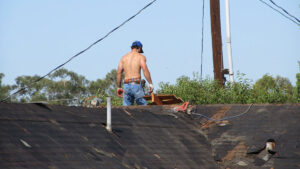When it comes to reroofing your home, tearing off the old roofing is a very common practice. While ripping off the old roof is usually the preferred option, there are other ways to reroof your home. These methods include bridging, butting up, and ice and water barriers. Bridging is a type of reroofing technique that uses the exposed portion of the shingle (also called a butt). Using a cant strip to create right angles is usually used for low-sloped roofing. Cap flashing, or a piece of metal that overlaps the base flashing, prevents water from leaking behind the base. Generally, cap flashing is not altered during the reroofing process.
In a flat roof, large sheets of roofing material or cloth impregnated with asphalt are used. These types of Roofing materials have the advantage of being stable on a flat roof. Another option is using a drainpipe. Drain pipes allow the water to flow away from the house without requiring a steeply pitched roof. A professional roofer should be consulted when deciding upon a roofing method, as any damage to the roof can have serious consequences.
If you’re looking to replace the roof of your house, consider installing new shingles. This type of roofing material is extremely popular but is expensive. Wood is also vulnerable to moisture and wildfire, so it’s not a practical option in humid areas. However, wood roofs are some of the most visually appealing roofing materials. Many luxury homes are equipped with this style of roofing. Redwood and cedar are two common choices. The materials are split to create wood shakes and shingles. These types of shingles are often thick wedges with a rough texture.
Traditionally, stone lintels were used to support roofs, but they have limitations. Several years ago, steel girders became the main structural support for homes. Today, you can even install solar panels on top of existing roofs. Some solar panels can be installed with additional weight on top to prevent uplift in strong winds. The roof of an Opera house is a great example of solar paneling. Roofing is an integral part of a home’s design, and it’s important to consider the materials used for your new roof.
While replacing a roof may be the best solution for your home, reroofing has its limitations, especially if your roof isn’t damaged significantly. It’s recommended to tear off the roof if you see significant damage in the top layer. But in many cases, you can get the same effect by reroofing. You will save money and time by avoiding the tear-off process. The only difference is that you’ll have to remove the old roof, which can be dangerous.
When it comes to re-roofing, it’s essential to understand how the square footage of your roof is calculated. A square roof contains 100 square feet. It’s important to note that many calculations ignore the “headlap” that occurs around the edges of the roof. A good contractor will know how to calculate the “headlap,” or space between shingles and the sides of the roof. In some cases, a headlap can skew the calculation.
Choosing the right type of shingles for your roof is an important part of the process. Quality re-roofing can be an excellent option if the deck of roof is not damaged. Choosing quality roof shingles is the key to a quality roof, and it can last for 10 years or longer. When choosing the right shingles, it’s important to consider how much maintenance is needed. This will depend on your budget and the type of shingles you choose.
Felts are another popular option for roofs. These are reinforced with organic or glass-fiber mats. Felts are generally waterproof and resistant to chemical spills. They can also help protect against bacterial growth and stand water, two things that can erode the life of a membrane. Thermoplastic membranes can also be extremely reflective, which can reduce your cooling expenses. They’re a good option for steep-sloped roofs.
Whether a roof is flat or steep is dependent on the climate where it’s built. The pitch of a roof is proportional to the amount of precipitation and climate in a particular region. Low-rainfall areas usually have flat or low-sloping roofs while snowy regions have high-sloped roofs. However, in the northern the minimum slope is six in 12 (1:2).
